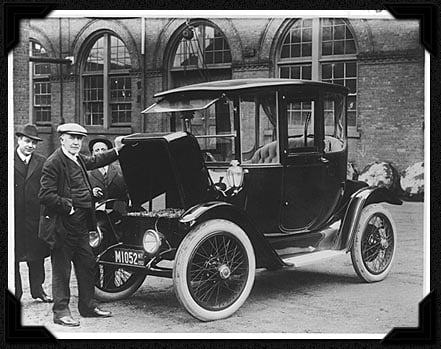So … since Sept. 15th to the 21st this year is “National Drive Electric Week,” I decided I wanted to investigate electric vehicle numbers and operation in the broader context of total vehicle numbers and operation.
In my previous post: “Thoughts on ‘National Drive Electric Week’,” and echoing what Plug In America had first so-declared in its Aug. 26, 2014 press release: “Record Number of Cities Observe 4th Annual National Drive Electric Week,” what I wrote was: “‘… Just as U.S. plug-in vehicle sales are expected to reach their first quarter-million mark, cities will offer one-day activities or observe the celebration’s entire week, organized nationally by Plug In America, the Sierra Club and the Electric Auto Association.’”
And, lo and behold, just 15 days after the group released its Aug. 26th release, a more recent press release making a Sept. 10, 2014 debut, in effect announced the sale of the two-hundred-and-fifty-thousandth electric vehicle (EV).
That it is what it is, at the end of the day and in the grand scheme of things, what does a quarter-million EVs on America’s roads or one-tenth of one percent of all on-road motor vehicles really tell us?
In looking at the amount of annual fuel required to provide for in excess of 2.97 trillion yearly vehicle travel miles, assuming an arbitrary average 17 miles per gallon (mpg) vehicle fuel economy rating, and using a per-capita yearly vehicle miles traveled average of 9,363, the two multiplied together yields an average per-annum, per-vehicle gasoline consumption rate of about 550 gallons. So, with 253 million motor vehicles logging in a single year close to 3 trillion miles, this more or less means a whopping cumulative total 174.71 billion gallons of fuel that autos and trucks traveling America’s highways and byways are sipping and gulping each year.
Now imagine a nationwide average auto mpg fuel economy rating of 22.5 (effectively a 33 percent improvement). This would result in annual net fuel consumption weighing in instead at 132 billion gallons, a savings of roughly 43 billion gallons.
Considering a nationwide average per gallon fuel price of $3.47, at that cost, over a year, gas collectively would cost American drivers $458.04 billion.
EV use by the numbers
Besting that, of course, is an EV’s fuel economy rating. To determine fuel-consumption equivalency, using my own cost for electricity or an average of $0.17 per kilowatt-hour ($0.17/kWh) based on my charges from Jul. 12-Aug. 12, 2014, say, for example, that to go 100 EV miles requires 25 kWh worth of battery charge (an estimate) and, providing I drove an EV, my cost would be $4.25.
Now, also, say, for example, the fuel-economy rating of the vehicle I do drive is 22.5 mpg, to go a hundred miles this would require 4.44 gallons of gasoline. At a cost of $3.47 per gallon, to drive that same distance would set me back $15.41 – nearly four times as much. If I were the typical driver, and to drive the average 9,363 per-capita vehicle travel miles, over a year’s time my car would consume 416.13 gallons of gas and my expenditure just for that alone would be $1,444.00, assuming, of course, that that per-gallon of gasoline price held.
On the other hand, an EV that requires 25 kWh of electricity to travel 100 miles, in driving at the average annual per-capita rate, provided I performed the math correctly, my total capital outlay for purchased electricity would come to just short of $398.00 and that’s for an entire year!
So, you can see the cost savings, although according to the U.S. Department of Energy, Energy Efficiency & Renewable Energy and the Office of Transportation & Air Quality, U.S. Environmental Protection Agency at www.fueleconomy.gov, the typical driving range for most EVs is from 100 to 200 miles, that is, on fully charged batteries.
Fuel cost is but one factor. But being vehicle purchase cost is another matter entirely, it is important to note different discounts, rebates, tax incentives, etc. regarding EV purchases are available. And there is more on this here.
EV reality
It may be a few years yet before the number of EVs on the road reaches a million. But, their ranks are swelling and are no doubt making their presence felt. Charging stations are becoming more and more and all this is encouraging news.
Whoa, Nelly!
Before I get too excited too quickly, without a commensurate increase in roadway capacity, whether accomplished via more pavement and/or improved technology and/or enhanced traffic management, more motor vehicles is more motor vehicles and absent sufficient capacity increase this could mean further traffic snarling and often tied to that, additional delay.
Emissions-free motoring is good; that and truly balanced transportation or mobility is even better.

– Alan Kandel
I came back from China where they have electric vehicle car share with
enormous vending machines for EVs…they are basing it off bike share to
get around the short term pitfalls of EVs. It has expanded to Shanghai
and will be spreading to other cities. You can see it here in this youtube video
The fine-particulate matter pollution (PM 2.5) in a number of China’s cities has been shown to be up to 10 times or greater compared to that which is present in cities having the worst particle pollution in America. So, I can understand the motivation or impetus behind such a car-sharing program.
That being said, from the video, how is the electricity needed for electric-vehicle-battery-charging/recharging generated? I believe this is an important question or consideration considering there exists the possibility that any benefit resulting from driving an electric car in China could be countervailed if the process of generating the electricity to charge/recharge said electric car batteries is net-negative, that is, if a net particle pollution rise as opposed to a net particle pollution decline results.
Irrespective of whether a net-negative electricity generation/electric-car-battery charging-recharging process or otherwise, restoring battery charge using photovoltaics technology (solar power) has its advantages and appeal and will bring added value.